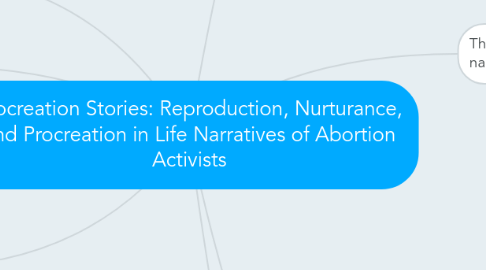
1. Abortion in Fargo, North Dakota
2. The pro-life movement in Fargo, the availability of abortion in their own community represented the intrusion of secularism, narcissism, materialism, and the reshaping of women into structural men.
3. The pro-life forces failed to close the clinic
4. The local controversy over the clinic opening in Fargo revealed at close range how the struggle over abortion rights had become a contested domain for control over the constellation of meanings attached to reproduction in America.
5. Reproduction, Generation, and Nurturance
5.1. Activists span and divide religious, ethnic, and occupational. lines
5.2. The core of membership on both sides was primarily white, middle class, and female.
5.3. The pro-choice activists clustered in a group born in the 1940s. Most had reached adulthood which meant they were married with children.
5.4. The right-to-life women cluster n rwo groups
5.4.1. Those born in the 1920's were most active in pro-life work in the early 1970's. The one currently most active, was born in the 1950's.
5.4.1.1. This latter group was made up of women who had worked prior to having children and left wage labor when they became mothers.
5.5. The battles that pro-life and pro-choice fight are loci for potential cultural and social transformation.
5.5.1. Change is incorporated, ordered, and assigned meaning by and for the individual.
5.6. Activists' views on abortion are linked to a very diverse range of moral, ethical, and religious questions.
6. The life stories: The pro-choice narratives
6.1. The pro-choice narratives were drawn from women activists who organized to defend the Fargo abortion clinic; most were born between 1942-1952.
6.2. A central figure of the current controversy in Fargo is Kay Bellevue, an abortion rights activist since 1972.
6.2.1. Her father was a Baptist minister; her mother worked as a homemaker and part-time public school teacher.
6.2.2. Like almost all of the women activists, regardless of their position on abortion, Kay's transition to motherhood was surrounded by ambivalence.
6.2.3. In 1972, Kay moved to Fargo; she remembers this transition as a time of crisis. Her parents were divorcing, one of her children was having problems, and Kay became pregnant for the fifth time.
6.2.4. "Then I ended up having an abortion myself. My youngest was 18 months old and I accidentally got pregnant. We had four small kids at the time and we decided if we were going to make it as a family unit, we had all the stress we could tolerate if we were going to survive."
6.2.5. "I think it's easy for them to stereotype us as having values very different than theirs and that's not the case at all. Many of the people who get abortions have values very similar to the anti-abortion people. The Right-to-lifers don't know how deeply I care for my own family and how involved I am, since I have four children and spent the early years of my life working for a breast-feeding organization."
6.3. Another abortion rights advocate Janice Sundstrom, like most of the pro-choice activists in Fargo, frames her story emphasizing her differentiation from, rather than integration with, her childhood in milieu.
6.3.1. 12 years in Catholic parochial school and marriage to her high-school sweetheart a year after graduation, followed immediately by two pregnancies.
6.3.2. "We were both 19 then and I didn't want to have another child. We were both in school and working and there we were with this kid. But I didn't have any choice. There was no option for me about birth control because I was still strongly committed to the Church's teaching. And then, three months later, I was pregnant again. After Jodie was born I started taking pills and that's what ended the Church for me.'
7. The Right-to-Life Narratives
7.1. Right-to-life activists express a similar concern for the preservation of female nurturance.
7.2. While it is linked directly to biological reproduction, nurturance in their narratives is not natural but achieved.
7.3. A speaker is Shirley, a 63-year-old widow, part-time nurse, mother of six, and a well-known member of Fargo's comfortable middle class
7.3.1. "Our Senator, he's not pro-life, sent me a congratulations letter when [my son] John got a teacher of the year award in 1980.1 wanted to take the letter back to him and say, 'It was very inconvenient to have this son. My husband was in school and I was working. We thought we needed other things besides a child. And had abortion been available to me, I might have aborted the boy who was teacher of the year.' What a loss to society that would have been. What losses are we having in society now?"
7.3.2. The first wave of right-to-life activity in Fargo received much of its support from women of Shirley's cohort, many of whom had recently been widowed and were facing the loss of children from their immediate lives as well.
7.4. In the pro-life view of the world, to subvert the fertile union of men and women, either by denying procreative sex or the differentiation of male and female character, is to destroy the bases of biological, cultural, and social reproduction.
7.4.1. This chain of associations to reproductive, heterosexual sex is central to the organization of meaning in pro-life discourse.
